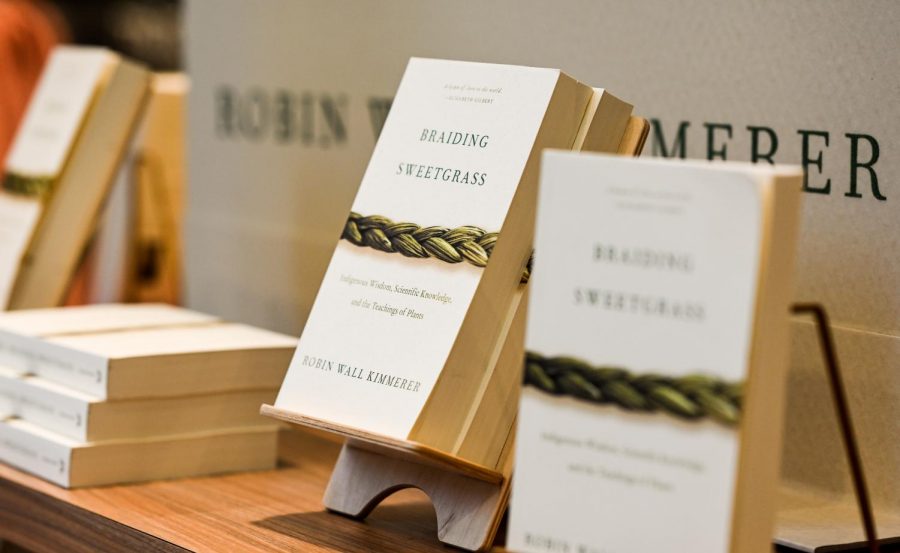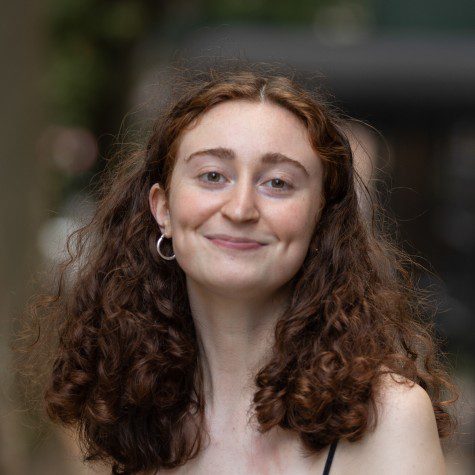Indigenous students demand visibility after being snubbed at NYU Reads event
Despite continuously contacting the university before an NYU Reads event, the Native American and Indigenous Students Group at NYU was left with only a few hours to prepare.
“Braiding Sweetgrass” by Robin Wall Kimmerer was chosen as this year’s NYU Reads selection. Members of the Native American and Indigenous Students Group at NYU have said that the university has failed to include them in the conversation about the reading. (Staff Photo by Sirui Wu)
October 8, 2021
Members of the Native American and Indigenous Students Group at NYU said they were not invited to participate in a community event about “Braiding Sweetgrass,” a book by Indigenous author Robin Wall Kimmerer about sacred environmental practices and knowledge. The book was chosen as this year’s NYU Reads selection.
Saira Coye-Huhn, a CAS junior and president of NAISG, said she reached out to NYU after her group was not contacted by the university during the organizational process.
“NYU had not made enough of an effort to try to involve the Indigenous population,” Coye-Huhn said. “I had spoken to other Indigenous faculty and students, and from what I was aware, no one else had been contacted.”
The virtual NYU Reads event, held on Sept. 30, was a discussion with Kimmerer, a scientist and member of the Citizen Potawatomi Nation. Although Coye-Huhn had continued to email the university since the beginning of September, the Office of Global Inclusion, which co-organized the event, only notified her on Sept. 27 that NAISG could be involved — and that they had until the end of the day to prepare.
“This should have been in discussion for a very long time, and the members of NAISG were definitely interested in helping with this event if we have been asked in advance,” she said. “We had to fight to be in this room. It feels like it’s this continuous situation where NYU pats themselves on the back for diversity and amplifying our voices when we’re the ones screaming to be heard.”
Coye-Huhn said that after sending a follow-up email on the morning of Sept. 27, the group was asked at around 1 p.m. to prepare a land acknowledgment, submit questions for a Q&A, and send the names and emails of students in NAISG for a meet-and-greet with Kimmerer. According to copies of the emails obtained by WSN, she had previously contacted the OGI on Sept. 13 and Sept. 22. She also met with staff in person on Sept. 24 but said she was still left to organize the event at the last minute.
Ariana Segovia, a Gallatin first-year and member of NAISG, said it was emotionally draining to have to draft a land acknowledgment under short notice.
“One land acknowledgment can be very draining to create,” Segovia said. “The reason for us being here is because of the displacement and the continuous genocide of Natives here. That’s hard to reckon with, especially as an Indigenous person.”
[Read more: What are NYU’s land acknowledgments worth?]
Coye-Huhn said that the group expected to talk with Kimmerer at the virtual meet-and-greet for 30 minutes, but the meeting instead felt like a “preparatory administrative meeting” with the event organizers.
“When we had time to speak, they gave us five minutes and we each got to ask one little question,” Coye-Huhn said. “In the same Zoom room was one of the only Indigenous pre-med students in their year. It’s not fair that the one time that they have an example to talk with someone who’s excelling in STEM as an Indigenous person, they don’t even have a chance to have those conversations.”
The event was also scheduled on the same day as Orange Shirt Day, which honors Indigenous children and survivors of residential and boarding schools in Canada.
“Considering that day was a day of mourning for a lot of Native people, it was a rough day,” Segovia said. “To some extent, I am really happy that it was a selected book and that it is really gaining a lot of traction and popularity. However, the fact that they didn’t reach out to the existing Indigenous community at NYU, to the club and to the only faculty member that is Native, I’m not surprised.”
The most recent statistics for faculty diversity at NYU are from the fall 2018 semester and show that of the university’s 6394 domestic faculty members, 14 identified as American Indian or Alaska Native, while 11 identified as Native Hawaiian or other Pacific Islander.
Coye-Huhn said the NYU Reads event is only one example of how the university is unprepared to deal with Indigenous issues on campus. She noted the lack of Native American faculty and staff employed by the university.
“You can look at how many people OGI employs, how many people the Provost’s office employs, how many people are employed on these diversity teams — it’s a lot of people, and they can’t find a single Indigenous person to hire,” she said. “We clearly don’t have enough people working on amplifying Indigenous voices and representing Indigenous voices. New York City has the largest population of urban Indigenous peoples, so they definitely have the resources and ability.”
She believes that the creation of a cultural center for Indigenous students, faculty and employees is a step towards visibility for the community.
“Students are tired of feeling unsupported at school,” she said. “A lot [of] Indigenous students talk about dropping out or have dropped out, or take very long gap semesters and we don’t hear about them for a while. That’s not fair and it’s completely the responsibility of NYU.”
Sabrina Choudhary contributed reporting.
Contact Rachel Cohen at [email protected].

























































































































































